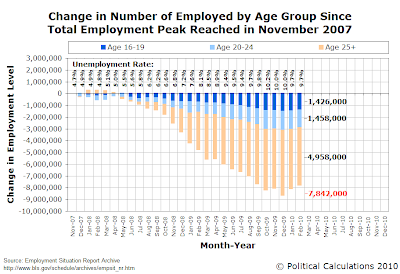February 2010 saw some improvements in employment with surprising demographic beneficiaries for the month: young adults and teens!

These figures are especially significant given that the percentage share of young adults within the whole U.S. civilian labor force is just 9.0%, while teens account for just 3.2% of all U.S. workers. Both percentage shares represent a slight increase over the all-time lows recorded in January 2010.
The timing of the improvement for teens and young adults corresponds well with anecdotal data indicating that firms go through a 3-to-6 month adjustment period following a minimum wage increase regarding the primary effects of minimum wage increases upon employment levels. Since teens and young adults represent approximately half of all those who earn the minimum wage, the bottoming out of each age group's percentage representation within the entire U.S. workforce in the six months after the final of the recent series of minimum wage increases was to be expected.
With no additional increases in the federal minimum wage scheduled to take place in the near future, we would now anticipate that teens and young adults will now disproportionately benefit by taking a disproportionately larger share of newly filled jobs as compared to older workers.
Labels: demographics, forecasting, jobs, minimum wage
Welcome to the blogosphere's toolchest! Here, unlike other blogs dedicated to analyzing current events, we create easy-to-use, simple tools to do the math related to them so you can get in on the action too! If you would like to learn more about these tools, or if you would like to contribute ideas to develop for this blog, please e-mail us at:
ironman at politicalcalculations
Thanks in advance!
Closing values for previous trading day.
This site is primarily powered by:
CSS Validation
RSS Site Feed
JavaScript
The tools on this site are built using JavaScript. If you would like to learn more, one of the best free resources on the web is available at W3Schools.com.